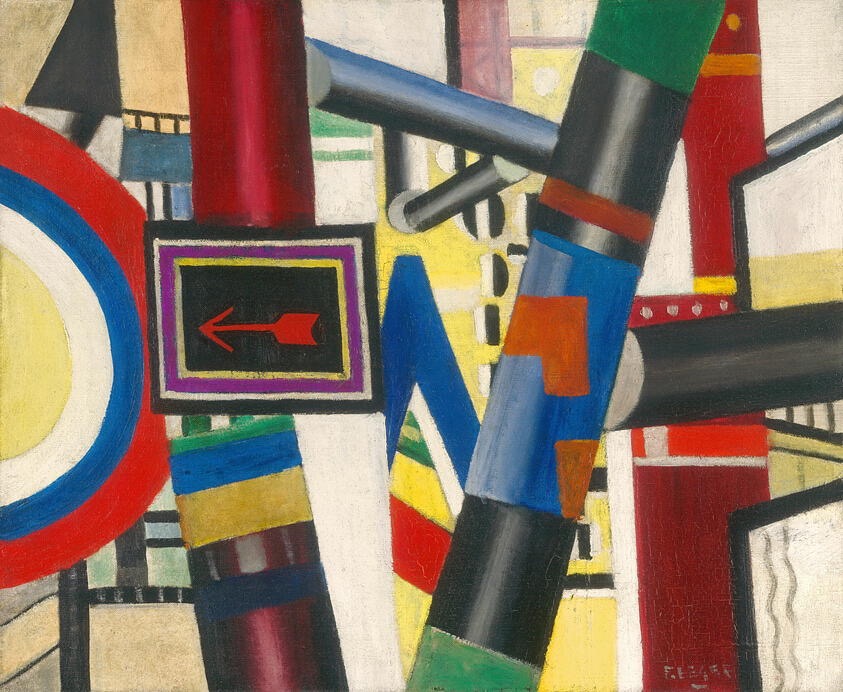ArrowingThrough

Fernand Léger:
The Railway Crossing (Sketch) (1919)
" … colleagues who don't quite understand why I don't quite understand."
Filled with the resolution of a new series, I chose to report what appeared to be a bug with my manuscripting system. I often work around shortcomings with software because I've been run around the block enough to understand that I'm probably misusing the system. Its keepers do not always warmly receive my reports. They often blame the messenger. Not that this messenger was ever necessarily blameless, mind you, but the interactions can feel abusive and are not always conducive to progress. Most of the systems I use feature areas where I, by experience or habit, refuse to go. I've learned that some functions work for others but not for me. I've grown to understand that I very likely misuse every system I employ, not just because they were seemingly designed backward, though most were. I cannot recall one I've used that was designed forward.
So, it was with circumspection that I reported this shortcoming. The manuscripting system enjoys wide acceptance and maintains a vast user community linked together for mutual support. Ask a question into that ecosystem, and perhaps a half dozen well-meaning colleagues will attempt to clue you in. This query was no exception. I described my problem, and in short order, I received an answer. I learned later that the responder was responsible for creating and maintaining the user manual, so her suggestion, well-meaning if slightly demeaning, was for me to refer to the user manual. She sort of led me to the water without demonstrating how I might drink. Still, she advanced my cause, and I responded appreciatively, even though, by following the manual, I managed to increase the number of bugs I created. I held my water since I had obviously not yet learned how to drink it by myself.
The manual directed me to ArrowThrough a page. This was new stage direction for me, and I wondered what it might mean. I Googled® the phrase and received pages filled with people modeling those stupid arrow-through-the-head things Steve Martin used to wear. That was no help, so I asked the assembled community what that might mean. A friend suggested a couple of interpretations, but neither seemed very explanatory. Later, the User Manual writer replied that she had changed the reference to “Examine each of the layouts…”. I finally figured out that I was being directed to scroll through a pull-down list and that an Easter Egg feature of that page's design included a function allowing arrow keys to scroll through lists. Such design conventions seem commonest now and amount to tacit operations. If you know it works that way, it works. If you don't know about it yet, you'd never guess. ArrowingThrough might be common vernacular in some worlds, but not yet in mine.
I still haven't managed to put together all the good advice I received to resolve my difficulty. I was not greeted as a complete idiot but more like a naive innocent who should probably know better but doesn't. This well describes my standard operating context. I do not naturally know better, nor am I always capable of learning. The User Manual my fellow pointed me to was written in the curious dialect of that particular software system. One must know what features are called to use it; those names remain largely opaque. I must learn a new vocabulary whenever I adopt a new system, which explains why I only hesitantly agree to adopt any new ones. I maintain many apps to which I couldn't adapt. The list of ones whose Easter Egg operation never popped is long and continues growing. Experienced users will not understand the problem, for they've transcended knowing how to operate the system. They no longer even think about how to do something as it's, through repeated use, become second nature for them.
I will continue to ArrowThrough as if I understood. I feel as though I'm standing atop a rickety chair to reach a high shelf whenever I use much of this stuff. Interface designers long ago lost the key to my heart. I will continue Honing my skills, though, for the alternative completely locks me out of my world. I had no idea until I asked that it's a commonplace convention to place a hashmark (#) after specific paragraphs to thereby denote a change of tone or scene. The hash marks I found throughout my draft manuscript presumed that my publisher or I observed that convention. I learned something. Soon, I might even discover how to remove those hash marks from my drafts, with a little help from my colleagues who don't quite understand why I don't quite understand.
©2023 by David A. Schmaltz - all rights reserved


